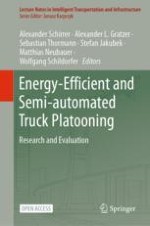This open access book presents research and evaluation results of the Austrian flagship project “Connecting Austria,” illustrating the wide range of research needs and questions that arise when semi-automated truck platooning is deployed in Austria. The work presented is introduced in the context of work in similar research areas around the world. This interdisciplinary research effort considers aspects of engineering, road-vehicle and infrastructure technologies, traffic management and optimization, traffic safety, and psychology, as well as potential economic effects.
The book’s broad perspective means that readers interested in current and state-of-the-art methods and techniques for the realization of semi-automated driving and with either an engineering background or with a less technical background gain a comprehensive picture of this important subject. The contributors address many questions such as:
Which maneuvers does a platoon typically have to carry out, and how?How can platoons be integrated seamlessly in the traffic flow without becoming an obstacle to individual road users? What trade-offs between system information (sensors, communication effort, etc.) and efficiency are realistic? How can intersections be passed by a platoon in an intelligent fashion?
Consideration of diverse disciplines and highlighting their meaning for semi-automated truck platooning, together with the highlighting of necessary research and evaluation patterns to address such a broad task scientifically, makes Energy-Efficient and Semi-automated Truck Platooning a unique contribution with methods that can be extended and adapted beyond the geographical area of the research reported.
